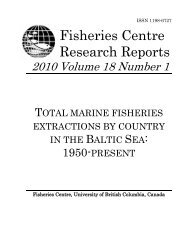Trends in GlobAl MArine Fisheries - Sea Around Us Project
Trends in GlobAl MArine Fisheries - Sea Around Us Project
Trends in GlobAl MArine Fisheries - Sea Around Us Project
You also want an ePaper? Increase the reach of your titles
YUMPU automatically turns print PDFs into web optimized ePapers that Google loves.
58<br />
latter be<strong>in</strong>g often used only for fishmeal, when<br />
not discarded, Pauly et al. 2002). Large fish, with<br />
their low natural mortalities and relatively high<br />
age at first maturity (Pauly 1980, Froese and<br />
B<strong>in</strong>ohlan 2000), cannot susta<strong>in</strong> much fish<strong>in</strong>g<br />
pressure and they decl<strong>in</strong>e (Denney et al. 2002,<br />
Cheung et al. 2007), forc<strong>in</strong>g the fishers to either<br />
move on to smaller fishes, and/or to other, previously<br />
unexploited areas. As larger fish tend to<br />
have higher trophic levels than smaller fish – <strong>in</strong>deed,<br />
the latter are usually the prey of the former<br />
– this process, now called ‘fish<strong>in</strong>g down mar<strong>in</strong>e<br />
food webs’, <strong>in</strong>variably leads to decl<strong>in</strong><strong>in</strong>g trends <strong>in</strong><br />
the mean trophic level of fisheries land<strong>in</strong>gs (Pauly<br />
et al. 1998a).<br />
This suggestion was <strong>in</strong>itially challenged<br />
(Caddy et al. 1998), but subsequent work, summarized<br />
<strong>in</strong> Table 1, shows the ‘fish<strong>in</strong>g down’<br />
phenomenon to be ubiquitous. For the various<br />
countries/areas covered <strong>in</strong> that table, ‘fish<strong>in</strong>g<br />
down’ implies a transition from fisheries target<strong>in</strong>g<br />
large fish (e.g. northern cod) to fisheries<br />
target<strong>in</strong>g smaller fishes (e.g. capel<strong>in</strong>), or <strong>in</strong>vertebrates<br />
(e.g., deep water prawn [Pandalus borealis]<br />
and crab [Chionoceters opilio]). However, the<br />
broad pattern is that of the fishers <strong>in</strong> a country<br />
or area target<strong>in</strong>g a succession of species (just as<br />
the Clovis hunter did), until the residual species<br />
mix ceases to support a fish<strong>in</strong>g (or hunt<strong>in</strong>g) economy<br />
(unless artificially ma<strong>in</strong>ta<strong>in</strong>ed via subsidies,<br />
Sumaila et al. 2007).<br />
Table 1. Contributions demonstrat<strong>in</strong>g the occurence of ’fish<strong>in</strong>g down mar<strong>in</strong>e food webs’ us<strong>in</strong>g local/detailed datasets, follow<strong>in</strong>g the<br />
orig<strong>in</strong>al presentation of this phenomenon by Pauly et al. (1998a), based on the global FAO land<strong>in</strong>gs dataset.<br />
Country/area Years Decl<strong>in</strong>e Source and remarks<br />
Iceland 1900–1999 1918–1999 Valtysson and Pauly (2003), based on comprehensive catch database of Valtysson<br />
(2001).<br />
Celtic <strong>Sea</strong> 1945–2000 1946–2000 P<strong>in</strong>negar et al. (2002), based on trophic levels estimated from stable isotopes of<br />
Nitrogen.<br />
India 1950–2000 1970–2000 Bhathal (2005), Bhathal and Pauly (2008).<br />
Gulf of Thailand 1963–1982;<br />
1963–1997<br />
1965–1982;<br />
1965–1997<br />
Christensen (1998); Pauly and Chuenpagdee (2003).<br />
Eastern Canada 1950–1997 1957–1997 Pauly et al. (2001), based on data submitted to FAO by <strong>Fisheries</strong> and Oceans Canada<br />
(DFO).<br />
Western Canada 1873–1996 1910–1996 Pauly et al. (2001), based on comprehensive dataset assembled by Wallace (1999).<br />
Cuban EEZ 1960–1995 1960–1995 Pauly et al. (1998), Baisre (2000).<br />
East Coast, USA 1950–2000 1950–2000 Chuenpagdee et al. (2003); emphasis on Chesapeake Bay.<br />
Ch<strong>in</strong>ese EEZ 1950–1998 1970–1998 Pang and Pauly (2001).<br />
West Central Atlantic 1950–2000 1950–2000 Pauly and Palomares (2005), based on FAO data (Statistical Area 41, see Ackefors this<br />
volume), disaggregated <strong>in</strong>to USA (North) and other countries (South).<br />
World, all fishes 1950–2000 1950–2000 Pauly and Watson (2003), based on spatially disaggregated data.<br />
FISH, SUSTAINABILITY AND DEVELOPMENT





![Nacion.com, San José, Costa Rica [Nacionales] - Sea Around Us ...](https://img.yumpu.com/26166123/1/190x245/nacioncom-san-josac-costa-rica-nacionales-sea-around-us-.jpg?quality=85)










